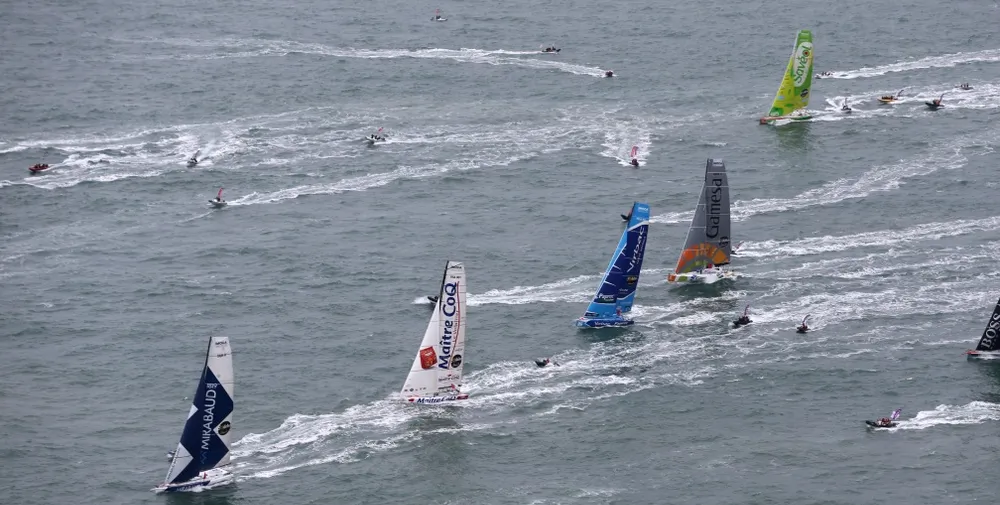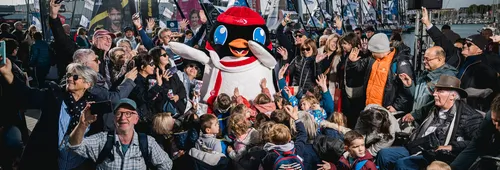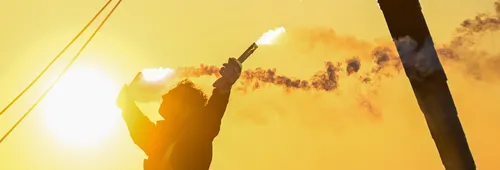Week 1
Saturday, November 10. More than 300,000 people were out early in the morning to give the twenty skippers a warm sendoff despite the rainy and cold weather. Just like in any of the previous editions, the channel moment was an emotional one for the sailors embodying the public’s dreams of adventure. French actor François Cluzet gave the start signal at 1.02PM. Five overeager competitors (Gabart, De Pavant, Gutowski, Le Cléac'h and Riou) crossed the start line early while Bertrand de Broc (Votre Nom autour du Monde avec EDM Projets), who had damaged his boat 25 minutes before the official start, was already back on the pontoons. He eventually left thirteen hours after the others and sailed across poor Marc Guillemot (Safran) who lost his keel after only 4h43 in the race. The Breton skipper was the first to pull out of the race. Young and spirited François Gabart (Macif) immediately took the lead of the fleet and sailed aggressively in a rough sea. Then, after three days of race, came the second abandon. Kito de Pavant (Groupe Bel) hit a fishing boat, ripping off his boomsprit and roof, while he was in the cabin for a ten-minute nap. The French sailor changed his route and sailed to Cascais, Portugal. Meanwhile, behind Gabart, Le Cléac'h (Banque Populaire) and Stamm (Cheminées Poujoulat) kept up with the leader’s intense rhythm, followed by Riou (PRB), who chose a more westerly route. This was the time for the very first tactical choices. That is when the youngest skipper in the fleet, Louis Burton, 27, also hit a fishing boat and decided to sail back to Les Sables d’Olonne to try to fix his damaged shroud. But Burton will eventually have to resign and pull out of the race. On the evening of Thursday, November 15, Samantha Davies (Savéol) dismasted in very rough weather conditions. She was the fourth sailor to pull out of the race and, after only one week, the Vendée Globe had already lost 20% of its fleet. Le Cléac'h became the new race leader off the Canary Islands, ahead of Gabart and Stamm. There are only 25 miles between the first three skippers and 100 miles between the first six.
Week 2
The remaining skippers were back in much nicer sailing conditions when, on November 17, Jérémie Beyou (Maître CoQ) broke his keel jack while sailing northwest of Cape Verde and eventually pulled out of the race two days later. On the same weekend, Alex Thomson (Hugo Boss) broke his rudder tie bar but managed to repair it without losing ground. Meanwhile, Javier Sanso (ACCIONA 100%EcoPowered) had to climb up his mast to fix his main sail traveller. The fleet was made up of three separate groups : the favourites (Le Cléac'h, Gabart, Dick, Stamm, Riou, Thomson), the senior outsiders (Golding, Wavre, Le Cam), and the « latecomers» (Boissières, De Lamotte, De Broc, Di Benedetto). On day 9, Le Cléac'h entered the infamous Doldrums, which gave the chasing skippers an opportunity to come back. That area of extremely unstable winds proved to be particularly tough on the leaders and their race became so close some skippers could actually see each other for a few hours! On November 21, after days of surprising route choices, Poland’s Zbigniew « Gutek » Gutkowski (Energa), abandons the race because of recurring autopilot issues. On the same day, Armel Le Cléac'h left the Doldrums behind and was the first skipper to cross the Equator. The chasing skippers followed him a few hours behind and closed the gap on him in the South Atlantic. Behind them, Mike Golding (Gamesa) crossed the Equator for the 22nd time and, after 12 days at sea, eight of the Vendée Globe skippers were in the south hemisphere, with Armel Le Cléac'h leading them for an entire week. Because of particularly southerly St Helena’s Highs, the first skippers had to choose a westerly route.
Week 3
On Saturday, November 24, Vincent Riou hit an Unidentified Floating Object - a massive drifting buoy – tearing the front part of PRB’s hull and seriously damaging the ourigger. After a first repair attempt, the former Vendée Globe winner eventually had to put an end to his race on the next day. Skippers’ strategies were exposed as Jean-Pierre Dick (Virbac-Paprec 3) moved away from the direct route and sailed south, soon followed by François Gabart, while Armel Le Cléac'h continued on the initial route. Skippers at the back of the fleet, led by Jean Le Cam (SynerCiel) with Mike Golding and Dominique Wavre (Mirabaud), started closing the gap. 250 miles behind the Swiss, Javier Sanso found himself 150 miles ahead of Arnaud Boissières (AKENA Vérandas).
Week 4
The different options chosen by the skippers started showing results on November 30, when the leader himself admitted the southerly route may have been the best. Dick briefly took the lead of the race on December 1, just before entering the « Great South » from Armel Le Cléac'h, who had led since November 16. In the process, the Virbac-Paprec skipper set a new 24-hour record, covering more than 500 miles – 502! – in a day. But François Gabart was the one crossing the first of the eight ice gates first. The leaders - Le Cléac'h, Gabart, Dick and Stamm – regrouped with Thomson 100 miles behind them while the pendant que les « senior sailors » tried to keep up with the rhythm 400 miles behind the front runners. On December 2, Jean Le Cam noticed a net was caught up in his keel and decided to dive to release it. The complex operation was a success and became one of the unforgettable moments in the race. On Monday, December 3, Armel Le Cléac'h was the first to round the Cape of Good Hope after 22d23h46’ of race, beating the previous record, set by Vincent Riou in 2004, by more than 24 hours. Finally, it was Indian Ocean time!
The leaders’ speed in such strong wind widened the gap between the frontrunners and the chasing skippers, with 2,200 miles (4,000 kilometres) between the leaders and the last skipper. The former tried to sail as fast as they possibly can to avoid the anticyclone threatening to catch up with them, which turned out to be difficult because of a tricky cross sea. While Armel Le Cléac'h was heading north to cross the ice gates, his opponents chose a curvier southerly route, despite the risk of coming across ice. Behind them, the « senior sailors » were in a close fight - Dominique Wavre and Jean Le Cam even sailed at sight for a few hours on December 7. Armel Le Cléac'h might have been the first to cross the Crozet gate, the anticyclone ended up catching up with him and the Banque Populaire skipper gave up his leadership position to Gabart and then to Stamm, before taking it back a few days later while the other skippers were forced to head north to cross the mandatory gate.
7 abandons
November 10: Marc Guillemot (5.45PM): lost keel
November 12: Kito de Pavant: hit a fishing boat
November 16: Samantha Davies: Dismasting on the evening of the 15th + Louis Burton: Hit a fishing boat on the 14th
November 19: Jérémie Beyou: keel jack issue discovered on the 17th
November 25: Vincent Riou: hit a UFO on the 24th
November 21: Zbigniew « Gutek » Gutkowski: Autopilot issue
THE picture
Kito de Pavant's sadness and disappoitment after pulling out of the race
© Ricardo Pinto / Windreport' / Groupe Bel
Highlights
November 10: Bertrand de Broc comes back to Les Sables d'Olonne 20 minutes before the start of the race to fix a hole in the bow.
November 12: Bernard Stamm faces his first hydrogenerators tie issues, the very first of a long list of problems for Cheminées Poujoulat.
November 15: Javier Sanso seeks shelter after a technical incident. He sails without his main sail for 32 hours before heading to the Canarias Islands. He is back in the race on November 17 with his boat at 100% of her potential.
November 16: Alex Thomson’s first repairs (Rudder tie bar)
November 21: 7 skippers are given a penalty for sailing across a cargo traffic lane (2 hours for Le Cam, Wavre, Sanso, De Lamotte and Gutek; 30minutes for Golding and 20 minutes for Dick)
December 1: Jean-Pierre Dick sets a new 24-hour record with 502 miles covered at an average speed of 20,9 knots.
December 2: Jean Le Cam has to dive under the SynerCiel hull to remove a fishing net caught in the keel. After a 30-minute operation, Le Cam is back in the race.
MACIF is the first to cross the Aiguilles ice gate at 19h01mn41s (UTC).
Rankings:
- Banque Populaire
- Virbac-Paprec 3
- MACIF
- Cheminées Poujoulat
- HUGO BOSS
- Gamesa
- SynerCiel
- Mirabaud
- AKENA Vérandas
- ACCIONA 100% EcoPowered
- Votre Nom autour du Monde avec EDM Projets
- Initiatives-cœur
- Team Plastique
Key quotes:
Marc Guillemot (FRA, Safran), November 11
« I am extremely disappointed and I really hope we can find out what happened. It’s tough, but it would take more than that to stop me. I know the disappointment will disappear eventually and we’ll try to move on and, most of all, to understand why this happened. The race goes on, I’ll keep thinking about all the skippers who are still in the race. »
Kito de Pavant (FRA, Groupe Bel), November 16
« The disappointment just won’t go away, it’s going to be a very long winter for Marc, Sam, Louis and myself. We’ll have difficult times. »
Jérémie Beyou (FRA, Maître CoQ), November 19
« The race is over and it makes me so angry. It shouldn’t have happened. When it did, I was so nervous it made me laugh because I just couldn’t believe this was happening. And then I was just mad and I stayed focused on the repairs. Yesterday, I haven’t been able to sleep at all. I ate a lot – there’s plenty of food – and eventually, I crashed in bed. I’m feeling a little better this morning, my mind is clearer. »
Armel Le Cléac’h (FRA, Banque Populaire), November 21
« We entered the southern hemisphere at around 8 AM. I’m doing fine, the champagne didn’t hit me too hard because I didn’t drink too much of it. I’m glad the part between Les Sables and the Equator is now over, the gaps aren’t too big and my fellow Vendée Globe skippers are close. The favourites are in good positions and we’ll have a nice fight over the next few weeks. »
Vincent Riou (FRA, PRB), November 25
« I took my time before making the decision because I wanted to make sure there was not the slightest possibility to stay in the race. But at one point, you have to be realistic and see there is no way I’ll be able to finish the race. That’s one of the most difficult things about being a skipper. Sometimes things are just not fair and you need to learn to accept that. If you don’t, it’s impossible to go on. But it’s hard, because we worked so hard before the race… »
Jean Le Cam (FRA, SynerCiel), December 3
« When you’re at sea, you just can’t go back any more but before the race starts, you ask yourself many questions. You have to think hard about everything before the beginning of the race and ponder every decision before going out there. If someone had told me I’d dive under my boat in the roaring forties, I would have thought that person is crazy… »
Video : Sam Davies pulls out of the race
Sam Davies après son démâtage/ after her... par VendeeGlobeTV







